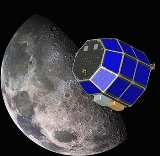
Lunar Atmosphere and Dust Environment Explorer
Encyclopedia
The Lunar Atmosphere and Dust Environment Explorer (LADEE) is a space exploration
mission scheduled for launch in early 2013. To carry out the mission NASA
will send a robotic spacecraft
into orbit
around the Moon
, and use instruments aboard the spacecraft to study the Moon's atmosphere and dust in the Moon's vicinity. Instruments will include a dust detector, a neutral mass spectrometer, an ultraviolet-visible spectrometer, and recently announced, a laser
communications (lasercomm) terminal. LADEE was announced during the presentation of NASA's FY09 budget in February 2008. It will be launched aboard a Minotaur V
from the Mid-Atlantic Regional Spaceport
.
on a Minotaur V
carrier rocket.
Space exploration
Space exploration is the use of space technology to explore outer space. Physical exploration of space is conducted both by human spaceflights and by robotic spacecraft....
mission scheduled for launch in early 2013. To carry out the mission NASA
NASA
The National Aeronautics and Space Administration is the agency of the United States government that is responsible for the nation's civilian space program and for aeronautics and aerospace research...
will send a robotic spacecraft
Robotic spacecraft
A robotic spacecraft is a spacecraft with no humans on board, that is usually under telerobotic control. A robotic spacecraft designed to make scientific research measurements is often called a space probe. Many space missions are more suited to telerobotic rather than crewed operation, due to...
into orbit
Orbit
In physics, an orbit is the gravitationally curved path of an object around a point in space, for example the orbit of a planet around the center of a star system, such as the Solar System...
around the Moon
Moon
The Moon is Earth's only known natural satellite,There are a number of near-Earth asteroids including 3753 Cruithne that are co-orbital with Earth: their orbits bring them close to Earth for periods of time but then alter in the long term . These are quasi-satellites and not true moons. For more...
, and use instruments aboard the spacecraft to study the Moon's atmosphere and dust in the Moon's vicinity. Instruments will include a dust detector, a neutral mass spectrometer, an ultraviolet-visible spectrometer, and recently announced, a laser
Laser
A laser is a device that emits light through a process of optical amplification based on the stimulated emission of photons. The term "laser" originated as an acronym for Light Amplification by Stimulated Emission of Radiation...
communications (lasercomm) terminal. LADEE was announced during the presentation of NASA's FY09 budget in February 2008. It will be launched aboard a Minotaur V
Minotaur V
The Minotaur V is an American expendable launch system derived from the Minotaur IV, itself a derivative of the Peacekeeper missile. It is being developed by Orbital Sciences Corporation, and is scheduled to make its maiden flight in 2012 carrying the LADEE spacecraft for NASA.The Minotaur V is a...
from the Mid-Atlantic Regional Spaceport
Mid-Atlantic Regional Spaceport
The Mid-Atlantic Regional Spaceport is a commercial space launch facility located at the southern tip of NASA's Wallops Flight Facility on the Delmarva Peninsula south of Chincoteague, Virginia.-Background:...
.
Mission objectives
LADEE is a strategic mission that will address three major science goals:- Determine the global density, composition, and time variability of the fragile lunar atmosphere before it is perturbed by further human activity;
- Determine if the Apollo astronaut sightings of diffuse emission at 10s of km above the surface were Na glow or dust and;
- Document the dust impactor environment (size-frequency) to help guide design engineering for the outpost and also future robotic missions.
Launch
LADEE is scheduled for launch on 15 January 2013 out of the Wallops Flight FacilityWallops Flight Facility
Wallops Flight Facility , located on the Eastern Shore of Virginia, is operated by NASA’s Goddard Space Flight Center, primarily as a rocket launch site to support science and exploration missions for NASA and other U.S. government agencies...
on a Minotaur V
Minotaur V
The Minotaur V is an American expendable launch system derived from the Minotaur IV, itself a derivative of the Peacekeeper missile. It is being developed by Orbital Sciences Corporation, and is scheduled to make its maiden flight in 2012 carrying the LADEE spacecraft for NASA.The Minotaur V is a...
carrier rocket.

